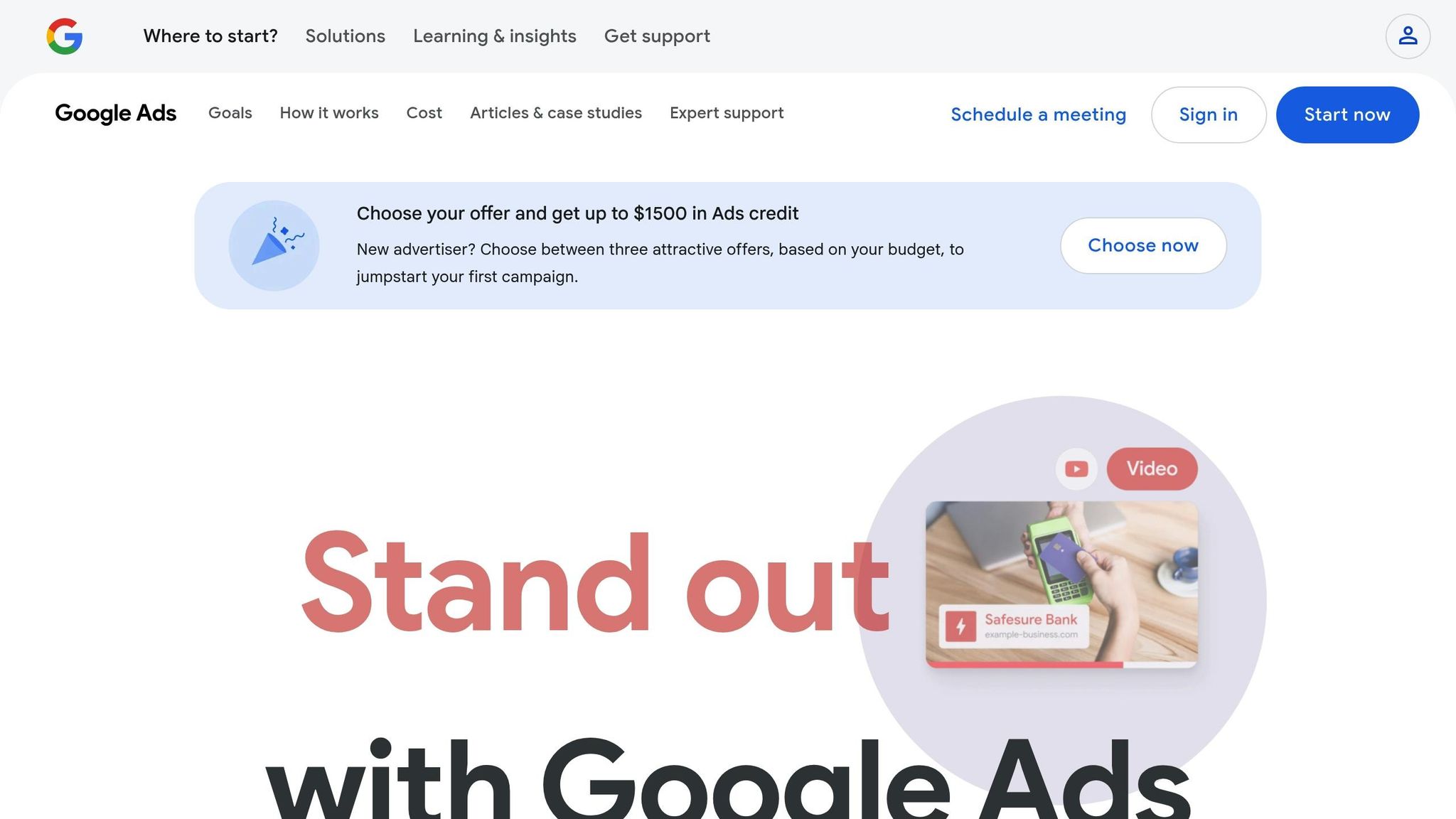Mistakes in PPC ad copy can waste money and hurt your campaign's performance. Here’s how you can avoid them:
- Common Errors: Spelling mistakes, unclear messages, keyword mismatches, platform policy violations, and weak CTAs.
- Why It Matters: Errors reduce click-through rates, lower quality scores, and damage credibility.
- How to Fix Them: Proofread carefully, align keywords with user intent, follow platform rules, and optimize CTAs.
- Tools to Help: Use tools like Grammarly for grammar checks, PPC analysis tools for performance insights, and scripts for bulk error detection.
Mistakes You Could Be Making in Your Google Ads Copy ...

Types of PPC Ad Copy Errors
Here are some common mistakes in PPC ad copy that can hurt your campaign's performance. From grammar slip-ups to policy issues, each error demands careful attention.
Spelling and Grammar Issues
Mistakes in writing can harm your credibility, such as:
- Misusing words like "their", "there", and "they're"
- Missing or incorrect punctuation
- Inconsistent capitalization
- Typos in brand names or product descriptions
Unclear Ad Messages
If your ad copy is confusing, users are less likely to engage or click. Some common clarity problems include:
- Vague value propositions
- Mixed messages between headlines and descriptions
- Conflicting promotional details
- Overly complicated language
Ask yourself: What are you offering? Why does it matter to the user? How can they take action?
Keyword and Intent Mismatch
When keywords don’t align with user intent, your ad’s relevance and performance suffer. This issue often shows up in:
- Ads targeting search intents unrelated to user needs
- Landing pages that don’t match the keywords used
- Ad copy that fails to support the user’s query
Platform Policy Violations
Breaking platform rules can lead to ad disapprovals. Common violations include:
- Overusing punctuation (like multiple exclamation marks)
- Using prohibited or restricted words
- Making misleading claims or guarantees
- Violating trademarks
- Formatting that doesn’t comply with platform guidelines
Poor Call-to-Action Text
A weak call-to-action (CTA) can mean fewer conversions. Typical CTA mistakes include:
- Using generic phrases like "Learn More" or "Click Here"
- Failing to match user intent
- Making actions unclear
- Lacking urgency or motivation
- Sending mixed signals compared to the landing page
How to Check PPC Ads for Errors
Basic Proofreading Steps
Start by carefully reviewing the main elements of your ad copy. A great trick is to read the ad backward - this helps catch spelling mistakes and ensures numbers, prices, and promotions are accurate.
Here are some helpful tips:
- Use a plain text editor to avoid formatting distractions.
- Read the copy aloud to spot awkward or unclear phrasing.
- Take breaks between reviews to keep a fresh perspective.
Keyword Review Process
Once you've proofread the basics, make sure your keywords align with your ad copy and overall campaign goals:
- Check that your keyword match types and ad copy align with the buyer's journey.
- Ensure the ad copy clearly supports your targeting objectives.
- Verify that keywords are naturally integrated into both the ad copy and the landing page content.
Policy Compliance Check
To avoid issues with platform rules, review your ad copy for compliance:
- Make sure your ad meets character count limits and formatting rules for the platform you're using.
- Double-check the use of brand names or trademarks to ensure they follow platform guidelines.
- Review the latest platform policies to confirm your ad avoids restricted terms, unverified claims, or other prohibited content.
CTA Quality Check
Your call-to-action (CTA) plays a key role in driving conversions. Evaluate it by asking:
- Is the desired action clear right away?
- Does it effectively communicate the benefits of taking action?
- If there’s a time-sensitive offer, is the deadline valid and specific?
- Does the CTA align with the rest of the ad messaging?
| CTA Element | What to Check |
|---|---|
| Verb Usage | Use strong, action-oriented words |
| Specificity | Clearly define the outcome or benefit |
| Relevance | Match the user’s search intent |
| Urgency | Include time-sensitive cues where applicable |
| Value | Highlight the benefit of acting now |
sbb-itb-89b8f36
Error-Checking Tools for PPC Ads
After conducting manual reviews, automated tools can help identify and fix errors in your PPC ad copy more efficiently.
Text Correction Tools
These tools help refine your ad copy by addressing grammar, readability, and tone:
- Grammarly Business: Offers real-time suggestions to fix grammar, improve tone, and enhance clarity.
- ProWritingAid: Analyzes readability and provides tips to make your copy clearer.
- Hemingway Editor: Highlights overly complex sentences and suggests simpler alternatives for better readability.
PPC Analysis Tools
These tools focus on performance data and quality metrics to uncover potential issues:
- Quality Score Analysis: Highlights mismatches between keywords and ad copy.
- Landing Page Alignment: Checks for consistency between your ad copy and linked landing pages.
Bulk Error Detection Scripts
Automated scripts, such as those available for Google Ads, can scan for common errors across campaigns, including:
- Missing punctuation in headlines
- Inconsistent capitalization
- Duplicate ads within ad groups
- Exceeding character limits
- Incorrect use of brand terms
- Price mismatches
- Expired promotional details
For a comprehensive comparison of these tools, check out the Top PPC Marketing Directory to find the best options for optimizing your campaigns.
Preventing PPC Ad Copy Errors
Avoiding mistakes in PPC ad copy not only saves time and money but also helps maintain ad performance. These strategies focus on spotting and stopping errors before they happen.
Ad Review Checklist
Use a detailed checklist to ensure all your ad versions meet quality standards. Here's what to include:
-
Pre-Launch Review
- Check character limits for headlines and descriptions.
- Verify URL structure and destination links.
- Ensure compliance with brand guidelines.
- Confirm accuracy of prices and promotions.
- Review for legal compliance.
-
Post-Launch Monitoring
- Track daily performance metrics like CTR (click-through rate).
- Keep an eye on Quality Scores.
- Analyze conversion rates.
- Monitor budget usage to avoid overspending.
Testing Ad Variations
Testing different ad versions is key to improving campaign performance over time. Start with a well-performing ad as your control group and change just one element at a time to measure its impact:
- Try different headlines.
- Adjust descriptions.
- Experiment with calls-to-action.
- Use alternative display URLs.
To get reliable results, make sure your tests meet these criteria:
- At least 95% statistical confidence.
- A minimum of 100 clicks per variation.
- Run tests for at least two weeks.
- Aim for at least a 10% improvement in CTR.
Policy Update Monitoring
Stay ahead of platform changes by regularly updating your internal policies and keeping your team informed.
Set Up Alerts for Policy Changes:
- Enable email notifications for updates from ad platforms.
- Subscribe to official advertising blogs.
- Participate in industry forums for insights.
Training and Documentation:
- Keep a current policy guide accessible to your team.
- Host training sessions every quarter.
- Document common policy violations and how to address them.
For more tools and resources, check out Top PPC Marketing Directory.
Conclusion
Error-free PPC ad copy plays a crucial role in driving campaign success. By keeping a close eye on your ads and correcting mistakes regularly, you can improve key metrics like Quality Scores, click-through rates, and conversions.
To achieve this, it’s essential to have a consistent process for reviewing and correcting errors. Use thorough proofreading techniques and leverage specialized tools to catch mistakes early. Remember, this isn’t a one-time task - regular audits are necessary to maintain top performance and ensure compliance.
For more tips, tools, and solutions to optimize your PPC campaigns, check out the resources at Top PPC Marketing Directory. They offer helpful tools to simplify your ad management and keep your campaigns running smoothly.
FAQs
How can I make sure my PPC ad copy matches user intent and avoids keyword mismatches?
To ensure your PPC ad copy aligns with user intent and avoids keyword mismatches, focus on relevance and precision. Start by conducting thorough keyword research to identify terms your audience is actively searching for. Use tools to understand search intent - whether users are looking for information, making comparisons, or ready to purchase.
Craft ad copy that directly addresses user needs by including primary keywords naturally and ensuring your message matches the intent behind those searches. Avoid overly broad keywords that could lead to irrelevant clicks. Regularly review your search term reports to identify mismatches and add negative keywords to filter out unrelated traffic. This approach helps improve ad performance, click-through rates, and ROI.
What are the best tools for identifying and fixing errors in PPC ad copy?
Detecting and correcting errors in PPC ad copy is essential for improving campaign performance. Some of the most effective tools for this include ad copy analyzers, grammar and spell-check tools, and platforms that specialize in ad performance insights. These tools can help you spot typos, ensure proper keyword usage, and optimize messaging for better results.
For a comprehensive solution, consider exploring platforms that provide A/B testing, keyword integration checks, and performance tracking. These features can help refine your ad copy and boost overall campaign efficiency. You can also visit the Top PPC Marketing Directory to discover expert-recommended tools and services tailored to your needs.
How often should I review my PPC ad copy to ensure it performs well and meets compliance standards?
To maintain optimal performance and compliance, it's a good idea to review your PPC ad copy at least once a month. Regular audits help identify errors, outdated messaging, or opportunities to improve click-through rates and conversions. For high-budget or fast-changing campaigns, consider conducting reviews bi-weekly or even weekly.
During these audits, focus on key areas like grammar, spelling, relevance to target keywords, and alignment with your landing pages. Staying proactive with your reviews ensures your ads remain competitive and compliant with platform policies.


